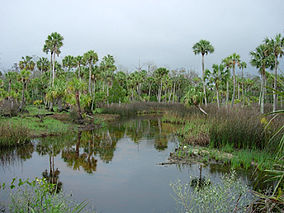Lower Suwannee National Wildlife Refuge
| Lower Suwannee National Wildlife Refuge | |
|---|---|
|
IUCN category IV (habitat/species management area)
|
|

Tidal creek off Dixie Mainline
|
|
| Map of the United States | |
| Location | Dixie County, Levy County, Florida, United States |
| Nearest city | Otter Creek, Florida |
| Coordinates | 29°19′N 83°06′W / 29.317°N 83.100°WCoordinates: 29°19′N 83°06′W / 29.317°N 83.100°W |
| Area | 53,000 acres (210 km2) |
| Established | 1979 |
| Governing body | U.S. Fish and Wildlife Service |
| Website | Lower Suwannee National Wildlife Refuge |
The Lower Suwannee National Wildlife Refuge (LSNWR) is part of the United States National Wildlife Refuge System. It is located in southeastern Dixie and northwestern Levy counties on the western coast of Florida, approximately fifty miles southwest of the city of Gainesville.
The 53,000-acre (210 km2) wildlife refuge was established in 1979 to protect one of the largest undeveloped river delta systems in the United States. It includes twenty miles (32 km) of the Suwannee River estuary and twenty miles (32 km) of coastline. The constant influx of nutrients from the Suwannee River combined with numerous off-shore islands and tidal creeks create excellent wildlife habitat which supports kites, bald eagles, manatees, sturgeon, deer, and turkeys, to name but a few of the species which take refuge there.
For tourists, the refuge offers bird and wildlife observation, wildlife photography, fishing, canoeing, hunting, and interpretive walks. As of 2005, a wildlife driving tour is under construction and several boardwalks and observation towers offer views of refuge wildlife and habitat.
The Suwannee River and nearby bottomland hardwood swamps, pine forests, cypress domes, tidal creeks, and vast salt marshes provide habitat for thousands of creatures every year. Many species including white-tailed deer, wild turkey, bobcat, bats, alligator, raccoon and river otter are present throughout the year — feeding, nesting, loafing, and roaming the forests and swamps. Gulf sturgeon, Florida salt marsh vole, eastern indigo snake, gopher tortoise, and wood stork are examples of threatened or endangered species that find suitable habitat within the Refuge. Numerous birds, including the striking swallow-tailed kite, bald eagle, osprey, prothonotary warbler, and dozens of species of shorebirds use the refuge seasonally then migrate farther south during winter months. More than 250 species of birds have been identified on the refuge, with at least 90 of those species actually nesting there.
...
Wikipedia

